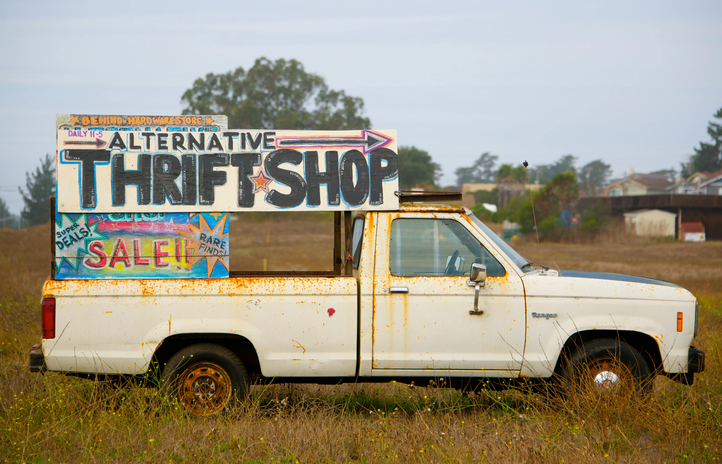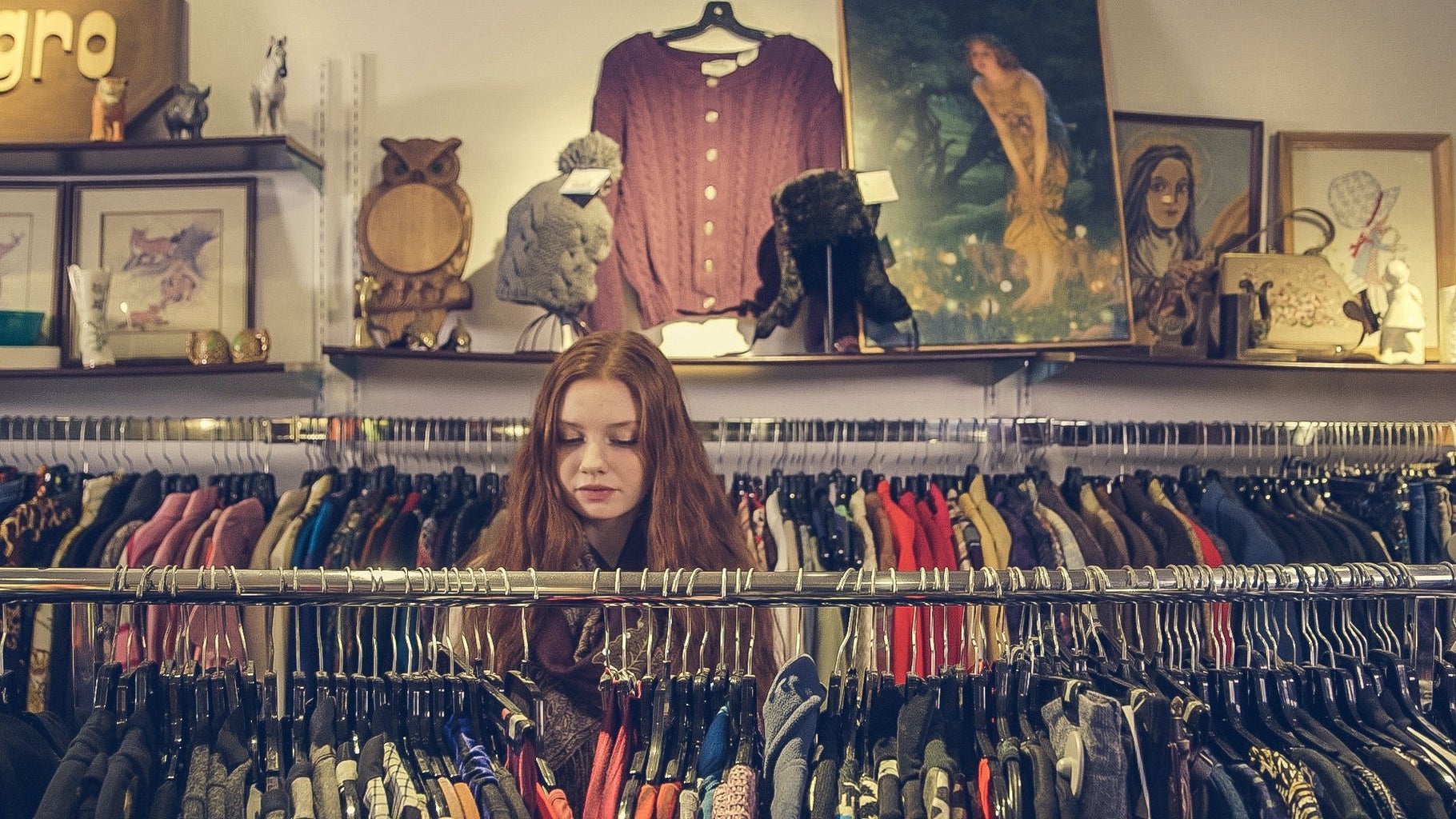Martha Ward, 21, holds a floor-length, blue velvet dress up to her webcam. A sea of navy fabric floods the screen. She raves about how much she loves the skirt’s subtle floral print over the glitchy Zoom call. Ward is sharing her all-time favorite thrift find, a Gap dress purchased from Goodwill for just $7.
Thrifting has become popular because of social media, says Ward. “We’re in the age when everything is in style. [Thrift stores] are great for finding things in different styles, finding your own style — and they’re so much cheaper.”
Like Ward, Jezreel Bodley, 22, is an avid thrifter. Bodley began thrifting back in high school as part of a social trend and later saw it as an eco-friendly alternative.
“I … started thrifting [because of] what my friends were doing with second-hand resale,” said Bodley. “I found it more sustainable that way. … I didn’t feel as bad about … the fast fashion trend that we’re seeing.”
Gen-Z youth are trying to decrease their environmental footprint and feed their consumptive tendencies by buying extensive wardrobes from thrift stores and vintage shops.
Though shopping second-hand is seen as a positive practice by young people, second-hand retail experts and low-income shoppers who rely on thrift stores say that the vintage shops Gen-Zers support create a decrease in access to affordable clothes for those in need.
“There’s definitely people who thrift because of the environmental impact piece,” said Jenna Pfueller, a thrift culture and DIY blogger for Goodwill. “But there’s also another portion of the population that thrift just because [they] like the thrill of the find.”

Shirley Bird, 66, has been thrifting all of her life. Bird says she prefers shopping at Salvation Army — as long as she has coupons — because it’s inexpensive.
“The biggest issue is that thrift stores used to be a great place for anyone looking for a job or going back to school,” said Bird, a retired Long Beach local. “They can’t get the cheap clothes anymore. [That] is a big impact for somebody who is trying to go back to work, or is homeless, and needs to buy a decent outfit to make that interview.”
However, the sudden popularity of thrifting among Gen-Zers, in addition to the rise of vintage stores, has changed thrift store inventories and prices.
Dalita Lovett, director of Resource Development for Salvation Army’s U.S. Western Division, says that this shift in second-hand inventories will not stop the continuation of thrifting practices.
“Thrift is here to stay. It’s not waning,” said Lovett. “College communities, younger communities … they really believe in that sustainability aspect.”
Second-hand stores date back to the Elizabethan era, according to JSTOR Daily. In the 1890s, Americans bought used items from “rag dealers,” but the pre-owned items carried a stigma. To combat the prejudice against buying second-hand, Christian organizations like Salvation Army began to use their department-like thrift stores to provide poor men with food, shelter and employment.
That remains their mission today.
“We’re looking at people who are economically disadvantaged,” said Al Hoeft, a spokesperson for Salvation Army Canada. “Certainly, there’s a great opportunity to provide good quality [clothes]. … But we’re able to provide … people who are economically disadvantaged, for whatever reason, [and] for however long, … appropriate things that they need … to move forward with their lives.”
In 2020, Gen-Z made up about 40% of the world’s consumers, according to McKinsey & Company. Controlling more than one-third of the consumer population indicates that Gen-Zers’ second-hand shopping is influential, both economically and socially.
Additionally, according to a report issued by Fortune, the fashion resale market grew nearly 21 times faster than traditional retail from 2019-2020. As a result, vintage stores that resell used clothes are part of a culture that has reached an all-time high.
Ashley Chi, 20, is a student at the University of California, Riverside, a thrifter and a supporter of local vintage shops.
“I think a lot of vintage shops also have thrift. … There’s different levels,” said Chi. “There’s some stuff that’s going to be a little cheaper, and then there’s some stuff that’s going to be on the higher end. It has to do with the labor it takes for the [buyers] that find these pieces.”
While vintage stores may look like deceptive thrift stores with higher prices, there is an exact definition used to determine if something is vintage.
“Vintage is known as 20 years old or older. And then antique is 100 years or older. And thrift is anything before the 20 years, before it becomes vintage,” said Johanna Moynahan, owner of FarOutfit vintage store in Long Beach, Calif.
Oftentimes, the cultivation of vintage stores’ inventories relies on the local thrift stores, such as Goodwill and Salvation Army. Sandra Conners, who is the founder of the nonprofit Thrift.Life and has worked in the thrift industry for more than a decade, has seen this with her own eyes.
“They get a lot of their stuff from thrift stores,” said Conners.
Conners adds that, unlike vintage stores, non-profit thrift stores sell items donated to them and then donate the money to communities in need, whereas vintage stores are usually for-profit businesses.
Bird recalls her own experiences with resale buyers scavenging through thrift store inventories.
“Resellers get out in time to buy anything that is super cheap off the shelves. … We encountered a reseller just last week in the Salvation Army who was looking to buy a Japanese bowl,” said Bird. “And they need to make their money — I understand that — but it has affected everybody.”
It should be noted, however, that not all vintage stores believe they follow this principle.
Moynahan says her vintage inventory and a small collection of thrifted items are sourced from an unnamed, used clothing warehouse in downtown Los Angeles that sells items by the pound. She has been buying inventory from this same location for nearly 15 years.
“There are many used clothing wholesalers,” said Moynahan. “There are always the most options in areas near ports because their bread and butter is exporting used clothing by the ton.”
In curating her store’s collection, Moynahan always keeps her younger customers’ styles and price ranges in mind.
“You know, most of my business is just jeans and T-shirts. So I do have a great selection of ’60s and ’70s stuff,” said Moynahan. “But I think [Gen-Zers] expect lower prices. … I mean, that’s really what people are looking for when they’re younger, when they want to change up their look and shop with their friends and stuff like that.”
Moynahan says she considers wearable garments under $30 within this lower price range and typically has a $5 rack for items that are only wearable after minor DIY modifications.
Some young consumers who thrift acknowledge that second-hand consumption is not always a matter of saving money out of need, but rather shopping out of personal desire.
“My parents came from Asia. They were poor. They were on welfare,” said Chi. “They thrifted not because it was a trend, but because it was something they had to do. … It’s definitely interesting to see the direction [thrifting] has gone. … Before, it was something that people might have needed to do, but now it’s something [where] people [who] have money will go out and thrift.”



